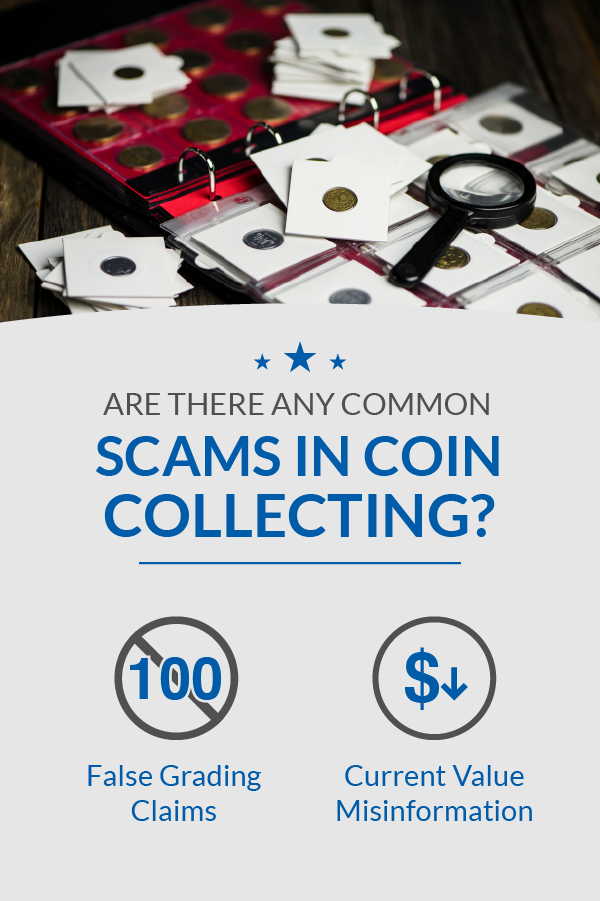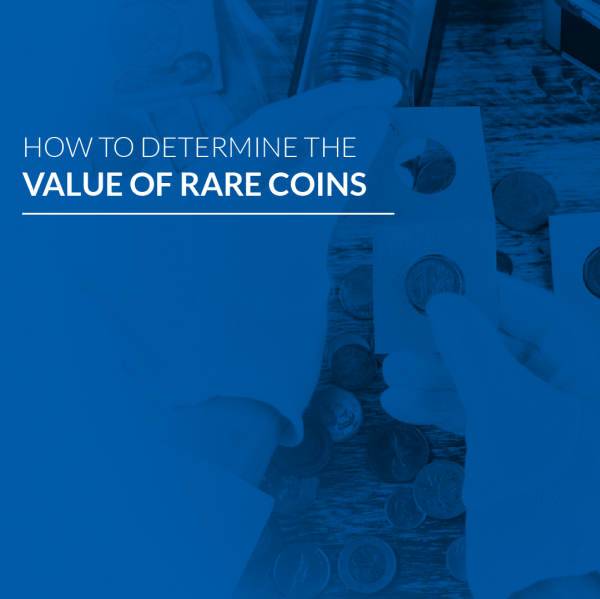Have you come into what you believe to be a rare coin recently? If so, your first question will likely be the obvious one — how much is this coin worth? It’s the first question most of us would ask, but unfortunately, it isn’t always simple to answer. Many different factors go into finding the value of rare coins, such as the year, the condition, the materials and the volume of the same coins that the government distributed in the first place.
While it can be a little complicated to answer the question of how to find the value of old coins, it's not impossible. With a little background knowledge and experience behind you, almost anyone can arrive at a fairly reasonable estimate of any rare coin’s value. Today, we want to walk you through this process and explain how to tell if a coin is valuable or not. By sticking with this guide, you should have no difficulty finding any rare coin’s value, within a reasonable margin of error.
How to Find out the Value of Rare Coins

Ready to find out how much that old coin is worth? Here are a few of the different routes you might take to do so.
1. Get an Appraisal
If you want to find a rare coin’s true value, your best bet is always to have the coin appraised. To do this, you’ll locate a local coin dealer and take the coin to them in person. They may be able to work off of photographs, but you’ll find that the appraisal is more accurate if the dealer can see and touch the coin for themselves. The dealer will look over the coin, compare it to their records, notes and guides and examine its condition. When they’re finished, they’ll quote you a price that they believe it is worth.
Keep in mind that just because a person calls themselves a coin dealer, this doesn’t necessarily make them reputable. If you accidentally find yourself doing business with a non-reputable dealer, you could be coming away with wildly inaccurate information. To make sure your dealer knows what they’re talking about and are a person to trust, look up a comprehensive list of registered dealers and ensure anyone you’re considering working with shows up on the list. Alternatively, do a bit of Google searching and see if it seems they can be trusted.
2. Do Some Reading
The professional coin world regularly publishes plenty of books and magazines with information regarding old, rare and popular collector’s coins. These publications often provide insight into what specific groups of coins are likely to be worth. Keep in mind that these are estimates only. The price quotes in a magazine may be what a coin in brand new condition would be worth, whereas the coin you have is a bit battered and discolored. Still, these estimates can be helpful in providing a general idea of what value your coin may have.
3. Do Some DIY-Work
As an amateur coin enthusiast, you likely don’t have the authority of a coin dealer, and so you can’t officially appraise a coin. With a little study and a lot of careful work, however, you can examine your own coins and compare them against official information to arrive at an estimate yourself. While this number will hold little weight in the professional world, it gives you a benchmark to work with, so that if you turn around to sell the coin or add it to a collection, you’ll at least have a rough idea of what it should be worth.
What Factors Go Into Determining the Value of Coins?

If you’re considering a DIY-appraisal, then the first step is to understand what determines the prices of coins. There are many different factors that work together to create a coin’s value. Aside from this, it’s important to understand the difference between value and price. Value is what a coin is objectively worth. Price, on the other hand, is the agreed-upon monetary value that someone has agreed to pay for it. Depending on the circumstances, this may be higher or lower than its objective value.
But while price is often subjective, value is less so. Here are some of the most common factors you’ll want to look at when trying to determine the value of a coin.
1. Mintage
Mintage refers to a line of particular coins that, when originally produced, were identical. These coins were made from the same materials, stamped with the same image and produced in the same year using the same die. As time passes and these coins circulate throughout the world, their condition inevitably changes. Despite this, we still say they’re of the same mintage.
Mintage affects the value of a coin because it is one of the major factors that determine how rare a coin is. For example, if only a small number of a particular mintage were ever created, the value is likely to be much higher than a mintage where huge numbers were created and sent out into circulation.
If you’re wondering how to find a rare coin’s value, start by determining how rare the coin is. How many were minted? While you won’t gain a dollar value from this question, you’ll begin to gain a sense of whether or not this coin is reasonably rare, or it’s just another of the millions of this mintage that were produced during the year in question.
2. Survival Population
The idea of survival population ties inextricably with a coin’s mintage. While mintage refers to the volume of identical coins that were produced, survival population refers to the volume of these same coins that survive to this day. For instance, say only a thousand coins of a particular mintage were produced. This makes the coin rare enough in and of itself. However, let’s also say that these thousand coins were minted two hundred years ago. Over those two hundred years, half the coins were destroyed or lost. That means only 500 are left in existence, thus reducing the volume and increasing the rarity.
As the rarity of a coin increases, the value almost always rises. Therefore, this is a crucial piece of information to research when determining the value of a coin and is something you should always look up in addition to researching the mintage. Even if the mintage seems to indicate that the coin is fairly common, don’t be sure until you’ve looked into the survival population. Together, these two categories will be your most valuable sources of information for appraising your coins.
3. Demand

If you’ve ever studied economics, you know that the driving factors behind price and value are supply and demand. The categories of mintage and survival population effectively cover "supply," so it only makes sense that we would next examine the idea of demand. Like anything else you can buy, certain coins are simply more in demand than others. This drives their value up, even if they’re inherently not worth more than other less-in-demand coins.
Plenty of factors influence the demand for a coin. Advertising campaigns might be set up that encourage collectors to hunt for a specific coin. A new series might be released that everyone is eager to own. Or it might simply be that the coin is rare, meaning more people are looking for it than can find it. This demand raises the value of a coin that was already valuable through its sheer rarity.
4. Melt Value
In the world of coin collecting, most people are more concerned about the coin as a whole, rather than the raw materials that make up the coin. The fact remains, however, that coins are made out of precious and semi-precious metals. This means if you were to take your coins and melt them down, the materials you’d have left as a result would still be worth something. If the coin is extremely rare, this melt value will certainly be less than the coin itself, but they will be worth something nonetheless.
Imagine a scenario where you had two coins of equal value in terms of how unique and rare they were. Both are part of a limited mint, and both are in great condition. If all of these factors left them standing at an equivalent value, what would drive one of them to be worth more than the other? It could be the melt value. If one rare coin was made of solid gold whereas the other was made of tin, the gold coin will almost always be worth more simply by virtue of its composition.
5. Grade/Condition
Coin grading is a complicated topic we won’t discuss in detail here. For our purposes, you’ll need to know that coin grading is a means of officially cataloging the condition of a coin. Every coin is eligible to receive a grade, no matter how unblemished and perfect or how faded and dirty the coin is. For your coin to receive an official grade, you’ll need to take it to a certified coin grader. This is an option that’s worth looking into, but if you’re only interested in your coin’s grade in a hypothetical sense, you can estimate a grade yourself.
It’s easy to see how grade affects a coin’s value. No matter how rare or common a coin is, in two coins of the same mintage, the coin with the higher grade will nearly always be worth more than the coin with the low grade. In other words, if everything else about the two coins is the same, the one in the better condition will have a higher value.
Are There Any Common Scams in Coin Collecting?

If you are new to the world of coin collecting, everything that goes into determining the value of rare coins can feel a bit overwhelming at times. You might be worried that, with nothing but a beginner’s knowledge of the subject, someone might try to take advantage of you by either charging you far too much for a nearly worthless coin or buying a coin off you for far less than its true value.
The best way to guard against these types of scams is to know what to look for. Here are some of the most common pitfalls to watch out for in the coin collecting world.
1. False Grading Claims
It’s easy enough to justify a higher selling price if the coin grade is high. The problem comes when the grade you see marked on the case, display or catalog doesn’t reflect the coin’s true condition. Dishonest dealers may try to pass off low-grade coins as higher-grade coins so that they can charge more for them. Some signs that this may be happening to you include coin cases or documents that appear tampered with or dealers who refuse to let you examine the case before making your purchase. If there’s nothing to hide, there should be no problem with you taking a look before you buy.
2. Current Value Misinformation
Let’s say a dealer is trying to sell you a fairly common coin. If they’re dishonest, they might try to claim the coin is worth far more than it is. They might claim that people around the world are paying the price they just quoted you and that you’re missing out on a bargain if you refuse. Under circumstances like these, it can be easy to feel pressured into making a deal. But if something feels off, it probably is.
The best way to protect yourself against these scams is to do your homework ahead of time. If you plan to buy a particular coin, try to go into the interaction with a pre-formed notion of roughly what the coin is worth. That way, you’ll recognize the scam when you see it coming and can identify an outrageous price as exactly that.
Browse Our Coin Selection Online Today
It’s one thing to understand the different factors that make up the value of a coin in theory. It’s another thing to put these ideas into practice, and the best way to do this is to simply begin. Start by building up your coin collection little by little. With every coin you purchase and even with every coin you choose not to purchase, you’ll gain more experience in judging the value of a coin. You’ll hone your sense of whether or not you’re being offered a fair price and, in turn, you’ll learn more about how to offer a fair price to others.
Are you ready to begin your coin collection? Shop our selection of rare and valuable coins here at American Mint. We offer a vast selection of different coins, and we also frequently discount many of our online items, offering them at unbeatable prices. We also have a money-back guarantee within 20 days of receipt if you're not satisfied with your purchase. Start by browsing our selection today and find that perfect coin to kick off your collection.
Sources:
1. https://png.memberclicks.net/find-a-png-dealer
2. https://www.americanmint.com/us-currency-american-currencies
3. https://www.thesprucecrafts.com/what-determines-the-value-of-coins-768726






